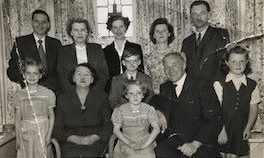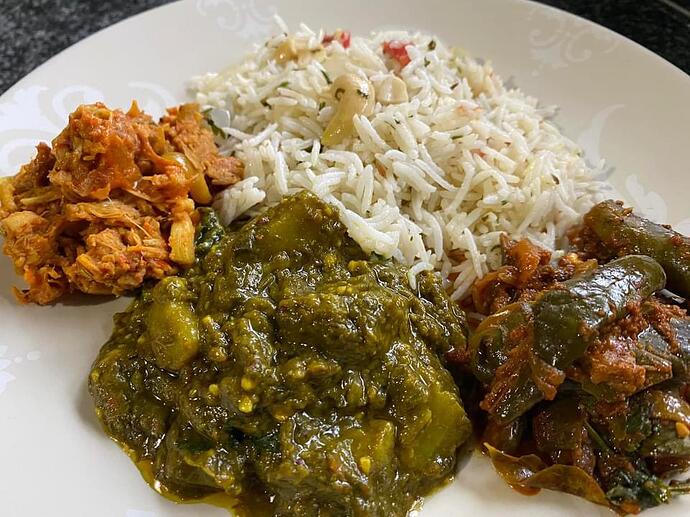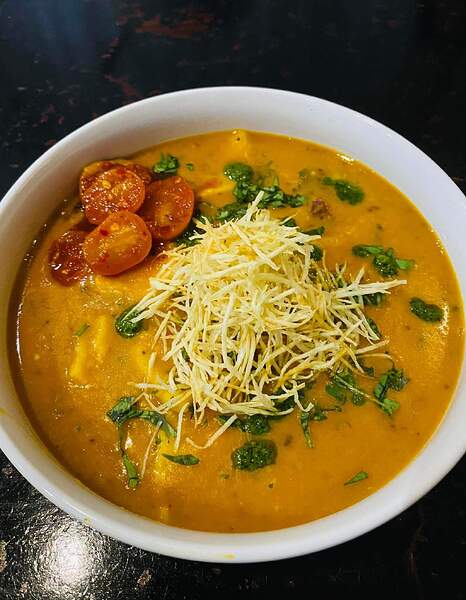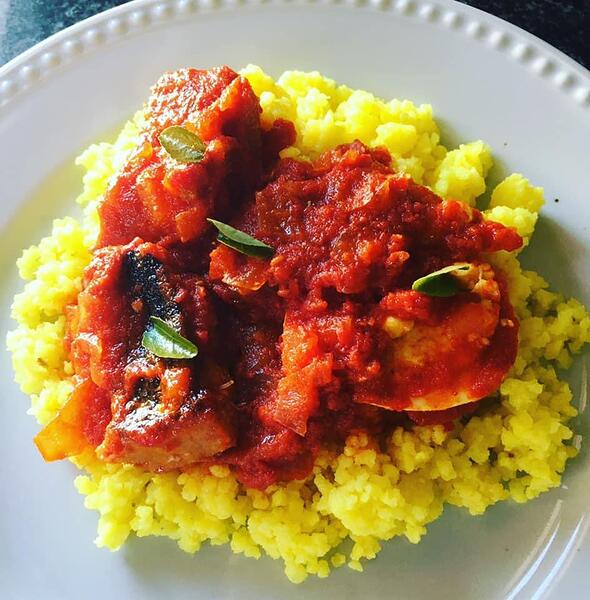Saw this vid and wondered, have you noticed how much diets have changed over the years? Can you remember what your grandparents ate? Do you agree with him?
Kanji Keerai remains one of the most popular meals for those descendants of indentured slaves living in South Africa.
Herbs growing inbetween sugarcane provided a rich source of nourishment for indentured workers. ‘Thabe’ herbs with sour herbs and green mangoes were popular ingredients for this heritage meal. Puli(tamarind) was added to the dish with vegetables like calabash and brinjal( sometimes) added to make the texture thicker.
The word “kanji meant using a wooden spoon and crushing the cooked vegetables with bountiful measurements of garlic, dry red and fresh green chilies though a sieve to give the dish a thicker consistency.” Dry fish was fried crisp and mixed into the dish for more variety.
Dried fish was the only source of protein that was served as part of the rations that the indentured workers received as part of their indentured contract. Mielie rice, not rice, accompanied the meal as the only form of starch, was added to make up this wholesome meal. The meal was often wrapped in banana leaves and taken to the sugarcane plantation as a lunch meal for the many slaves working from sunrise to sunset.
DHALL PITA. One of the most beautiful meals that continues to provide comfort as a tribute to the resilience of the indentured slave ancestors in South Africa. Dhall was the agreed ration for all Indentured slaves on the ship voyages and while they toiled on the sugarcane plantations. In most instances dhall was all they received.
Indentured Ancestry food. A simple meal of mielie rice with dry fish chutney and boiled eggs was the only protein intake for many indentured slave families working on the plantations here in South Africa. Maize had to be adapted to resemble rice that was the staple of many of the worker immigrants of colonial Natal.
These simple recipes are still the best.
My grandparents ate , sausages cooked in dripping, mashed potatoes, mixed with butter and cream, and greens in honey , with the dripping fat poured over the whole meal……i loved that meal, when i visited them….
Plus ……nan , made me drink the greens water , which i also liked ….
Also Azz I’m sure eating was largely more structured as in set meal times. There certainly wasn’t as much snacking and scoffing in-between. It just wasn’t done and the variety of junk food readily available was nothing like today. Breakfast , lunch and dinner. Maybe tea and a couple of custard creams at eleven ![]()
We lived in different countries but I think they used to eat a lot of beans and greens (oh, it rhymes!) to make up for the proteins, vitamins iron intake that they couldn’t get from meat because it was too expensive.
My grandparents had meat and two veg, booze, cigarettes, little or no prescribed pharmaceuticals, no TV …
I cannot remember as far back as 1920s/1930s and both my grandmothers died before I was born but my Great Aunt acted as my Grandmother.
She was born at the turn of the century and worked as a cook from the 1920s onwards. She taught me to cook, so I can remember the types of meals that were served.
She made bread and rolls, mostly from brown flour but would make some white bread too - there was nearly always bread and butter served with every meal.
Meat was usually a cheap cut, cooked slowly for a long time in the oven at the side of the kitchen fire.
Every scrap of the animal was used, saving the fat for roasting and boiling the bones for stock to make soups and gravies.
Meat portions were small, because it was more expensive.
The mincer got a lot of use to mince up bits of meat, suet to mix with breadcrumbs, herbs and seasonings, to make sausages or meatloaf.
Wild Rabbit would be on the menu if someone had been out shooting them. I hated the job of skinning and gutting them. I didn’t like meat anyway and didn’t eat it but I still had to skin rabbits and pluck chickens … ![]()
Sometimes, when money was tight, the meal would be mostly root veg and onions, “flavoured” with just a few bits of meat or meat stock.
Panackelty was often on the menu - layers of potato, onions and thin slices of bacon, baked very slowly in the side oven.
Sundays was always a roast dinner of some kind - and that joint of roast meat was eked out sparingly and usually provided meals for several days after.
The meal would often start with each person getting a 7” inch diameter Yorkshire Pudding on their plate, filled with onion gravy.
After you polished that off, the edge was taken off your appetite.
Then you got a huge pile of mashed potato (mashed with butter) a couple of roast potatoes, a big spoonful of mashed swede and carrot (mashed with butter), a large spoonful of cabbage, or maybe peas or beans if they were in season, with lashings of gravy.
The meat was dished out according to age and the physical work each family member did - the manual workers got a bigger share as they needed to maintain their muscles to keep working.
As a kid, I was quite happy to give up my share of the meat and happily tuck into the mash and veg.
The water from the cabbage was saved to make the gravy or given to the kids to drink.
Puddings were usually stodgy - stewed fruit would usually be encased in a pie crust or crumble or sponge topping to make it more filling, then smothered with custard.
Then teatimes would be sandwiches, scones and cakes and on Sundays there would maybe a trifle.
Thinking about the types of food, it was very high carb and high fat - yet we were all skinny creatures.
I think not having processed food was part of it - and not having snacks between meals was another part of it - but what the video presenter did not mention is the other big lifestyle change since 1920s - motor cars and other road transport has vastly reduced the amount of calories people use up in just going about their daily lives and so do gadgets like washing machines, vacuum cleaners, electric mixers, power tools …
In this age of door-to-transport and labour-saving devices, if people continued to consume the high carb, high fat diet our Great Grandparents used to consume, they probably wouldn’t be as slim as the average size of people in 1920s - not unless they expended the same amount of calories as they did.
Just about every task in the home and in the workplace involved more manual labour and physical activity than it does now.
Del Monte canned pears with evaporated milk…
Milk jellies . Apple dumplings with custard .
Heinz spaghetti on toast .
Sunday Roasts
Big stew and dumplings .
Cooked breakfasts
They kept hens while living in the East End.
Grandad grew veg and Sweet peas.
My sister and I would spend school holidays at our grandparents’ house because both of our parents worked, arriving there at 8am each day and leaving around 6pm to go back home. We were given home grown vegetables and fruit. Meat and two veg for most meals all cooked from scratch. Yorkshire pudding served as a dessert with home made raspberry vinegar (delicious!). Grandma would bottle surplus veg, such as runner beans, in salt. Home made pickles and bottled plums. Grandma’s speciality as far as I was concerned was spotted dick - steamed in muslin and served with lashings of home made custard. At teatime we would have home made bread with butter and home made jam. My grandad grew tomatoes in his greenhouse and I have never tasted any quite like those he allowed me to pick and eat - still warm from the sunshine.
The video was interesting. I’ve seen old footage many times from way back, and people have usually been all shapes and sizes - not just skinny as shown on that video.
I can’t remember exactly what my grandparents ate, but i know what they didn’t eat - takeaways, for example, as there were very few back then. Maybe the odd fish and chip shop (UK), and that was a treat every now and then.
Also,portion sizes were rarely as large as they seem to be these days.
Yes anise , the portions now are so huge
My husband and i only have half each of all the one portion meals ,
Grandfathers favourite dish was cod cheeks. But he was the skipper of a trawler so had access to enormous fish…
Both my Grand Parents were well off compared to my own Parents.
Mother’s parents had Shirley Hardware Stores on the Wickham Road Shirley and during the war and even after when ration books were still in place they never went without as they bartered with the other shop keepers.butcher bakers and ‘‘candlestick makers’’…Nana Louise would come over on the bus to us in Stretton Road Croydon and always armed with a huge box of cream cakes from the… think it was called the Blue Bird was a bakers anyhow. Grandad Herbert had a fishing boat at Newhaven with a friend we called Uncle Les and his wife Aunty Win…as kids we stayed with them often…Meals with Nana Louise and Grandad Herbert were hap hazard as they were always serving in the shop and regular times were not regular to us… Salads were always likely and cold meats cheeses with pies/pasties bought from the next door bakers. Very tasty but no idea what really was in them as in good quality fillings or not… fresh vegetables in abundance. Nana smoked cigarettes from a red square box thinking it was du maurier or similar name…Grandad Herbert smoked old holborn and smoked a pipe as well. He had his local pub called the Red Poppy Inn and spent time in there as often as he could…He looked like a boozer on reflection as he had a red nose that was bulbous as well. He collapsed on our Beddington House Front Steps one night whilst returning home with my Parents…the air caught him out…as did the alcohol consumption. He did die of Lung Cancer though…
My Dad’s folks were middle class I would say. He was a professional photographer and Nana Kurn was the one who ran the household. I see her as always had a pinny on…Baked a lot cooked meals a lot and only ever made fresh meals from scratch…Traditional meals with lots of vegetables and traditional puddings like syrup sponges apples pies spotted dick and rice puddings…
They lived in Bromley Kent and we use to stay over often at weekends…They paid for a taxi to and from each house…have one photo with us all about to get in a taxi… I will find it and post it…I recall the garden was covered in trailing fuchsias. Think they might have been roses though as I don’t think fuchsias trail like roses do around arches…Nana Kurn she died young with a Heart Attack…I know she smoked a lot… Grandad Kurn retired to Folkstone and re married a spinster who had a terrible stroke not long after they married, but he did nurse her really well to the end.
… He was old when he died but it was a Cancer that killed him. Healthy living I really do not know that…Food was in abundance and home cooked but my memory as to what we had is vague apart from traditional foods…
found one not the taxi one but a family of Kurns…

left front sister Jacqueline Kurn, Nana Kurn, Dianne ,Grand-dad Kurn
Cousin Carol Kurn Uncle Arthur’s daughter, back left My dearest Dad and Mother then Aunty Jean Dad’s sister, Aunty Win and Uncle Arthur Dad’s brother and Cousin Michael Kurn …Uncles Arthur’s Son in the centre
Just traditional British food,no foreign foods at all.
Me…i am the opposite,English/Indian/Chinese/Italian/Mexican and French.
HaHa yes 50s/60s junk food.
Certainly was fast food😉 but innocent junk food when compared to todays offerings.
As I was raised by my paternal grandparents from the age of 5, remembering what we ate is easy. During and just after WWII food was not easy to source due to tight rationing, but being publicans, under counter food was reasonably easy get hold of. We ate reasonably well, but not the greasy spoon type of pub-grub sold to the regulars; no, we enjoyed good traditional Jewish food and plenty of it too. TBH, I don’t know how the regular shmucks ate all of those greasy platters, but I suppose the copious beer swilled at the same time washed it well down while the piano played (music licence)![]()
we enjoyed good traditional Jewish food and plenty of it too
I love a good salt beef sandwich, gherkin & mustard.
I agree with your choice of sandwich, but if in a rush then corned beef will do ![]()
I agree with your choice of sandwich, but if in a rush then corned beef will do
Interesting comment, “corned beef” not had that in years, might get some, but as I remember it’s not much like salt beef.
I googled, as the inquisitive mind does and came up with this:
https://separatedbyacommonlanguage.blogspot.com/2007/09/salt-beef-corned-beef.html




